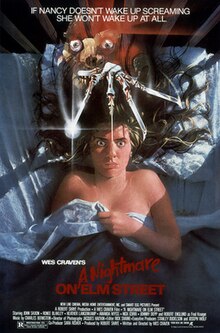A Nightmare On Elm Street
| A Nightmare on Elm Street | |
|---|---|

Theatrical release poster
|
|
| Directed by | Wes Craven |
| Produced by | Robert Shaye |
| Written by | Wes Craven |
| Starring | |
| Music by | Charles Bernstein |
| Cinematography | Jacques Haitkin |
| Edited by |
|
|
Production
companies |
|
| Distributed by | New Line Cinema |
|
Release date
|
|
|
Running time
|
91 minutes |
| Country | United States |
| Language | English |
| Budget | $1.8 million |
| Box office | $25.5 million |
A Nightmare on Elm Street is a 1984 American supernatural slasher film written and directed by Wes Craven, and the first film of the Nightmare on Elm Street franchise. The film stars Heather Langenkamp, John Saxon, Ronee Blakley, Amanda Wyss, Jsu Garcia, Robert Englund, and Johnny Depp in his feature film debut. The plot revolves around several teenagers who are stalked and killed in their dreams (and thus killed in reality) by Freddy Krueger. The teenagers are unaware of the cause of this strange phenomenon, but their parents hold a dark secret from long ago.
Craven filmed A Nightmare on Elm Street on an estimated budget of $1.8 million, a sum the film earned back during its first week. The film went on to gross over $25 million at the United States box office.A Nightmare on Elm Street was met with rave critical reviews and went on to make a very significant impact on the horror genre, spawning a franchise consisting of a line of sequels, a television series, a crossover with Friday the 13th, beyond various other works of imitation; a remake of the same name was released in 2010.
The film is credited with carrying on many tropes found in low-budget horror films of the 1970s and 1980s, originating in John Carpenter's 1978 horror film Halloween, including the morality play that revolves around sexual promiscuity in teenagers resulting in their eventual death, leading to the term "slasher film". Critics and film historians state that the film's premise is the struggle to define the distinction between dreams and reality, manifested by the lives and dreams of the teens in the film. Critics today praise the film's ability to transgress "the boundaries between the imaginary and real", toying with audience perceptions.
...
Wikipedia
